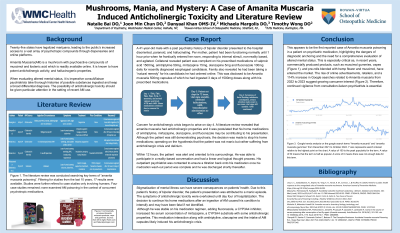Psychopharmacology and Toxicology
(144) Mushrooms, Mania, and Mystery; A Case of Amanita muscaria Induced Anticholinergic Toxicity and Literature Review


Natalie A. Bai, DO (she/her/hers)
Child and Adolescent Fellow
Westchester Medical Center
River Vale, New Jersey- JC
Joon Min Chun, DO
Resident
Rowan Virtua School of Osteopathic Medicine
Cherry Hill, New Jersey - DK
Danyaal Khan, BA Biology
Third year medical student
Rowan-Virtua School of Medicine
Mount Laurel, New Jersey .jpg)
Timothy L. Wong, DO
Director of Consultation-Liaison Psychiatry, Associate Program Director of Residency Training
Rowan-Virtua School of Osteopathic Medicine
Philadelphia, Pennsylvania- MM
Michaela Margolis, DO, DO
Child and Adolescent Psychiatry Fellow
Tufts Medical Center
Boston, Massachusetts
Presenting Author(s)
Co-Author(s)
Significance:
Amanita muscaria (AM) is a mushroom with active compounds of muscimol and ibotenic acid. It has potent anticholinergic activity, hallucinogenic properties and is sacred in some cultures(Michelot, 2003). Currently, it is sold online for recreational use.
Today, the public has access to an increasingly wide breadth of compounds through dispensaries and online platforms. It is imperative that consultation-liaison psychiatrists take thorough histories and keep a broad differential diagnosis when evaluating altered mental status. The possibility of anticholinergic toxicity should be given particular attention in the setting of recent AM use.
Case:
A 41-year-old white male with bipolar disorder presented to the hospital disoriented, paranoid, and hallucinating. His vital signs demonstrated tachycardia, hypertension, and tachypnea. Per mother, patient was functioning normally one hour earlier. Urine drug screen was negative.
Patient was compliant on his prescribed medications of valproic acid 1500mg, amitriptyline 50mg, mirtazapine 15mg, olanzapine 5mg and Fluconazole 100mg daily for recently diagnosed esophageal candidiasis. Patient’s mother disclosed that he had taken three AM 500mg capsules that morning to treat his fungal infection “naturally”.
The patient’s home medications were continued, but he remained agitated, disorganized, and sleepless. He exhibited flushing, anhidrosis, urinary retention, constipation, and hemodynamic instability, remaining unchanged for 72-hours. Concerned, the psychiatry team conducted a literature search revealing AM could precipitate anticholinergic crisis. This condition was exacerbated by restarting the multiple anticholinergic agents in his home medications. Amitriptyline, mirtazapine, olanzapine, and valproic acid were tapered down over 24 hours and the patient returned to baseline overnight.
Discussion:
Stigmatization of psychiatric illnesses can have severe consequences on patients’ health. Due to his history of bipolar disorder, this patient’s presentation was attributed to a manic episode. The symptoms of anticholinergic toxicity were overlooked. Continuing his home medications after an ingestion of AM caused his condition to intensify and may have been fatal.
Although he was stable on his medication regimen, adding fluconazole, a CYP3A4 inhibitor, increased the serum concentration of mirtazapine, a CYP3A4 substrate with slight anticholinergic properties. This medication interaction along with amitriptyline, olanzapine, and the intake of AM capsules likely induced anticholinergic crisis.
Per literature review, ten cases of AM poisoning have been documented. Most cases are serious and require ICU level of care if raw mushrooms are consumed. One case published in 2021 describes the death of a patient who ingested AM for recreational use, highlighting the dangers of this compound(Meisel, 2022).
Conclusion:
To our knowledge, this is the first case of AM poisoning in a patient on psychiatric medication. It highlights the dangers of diagnostic anchoring and the importance of thorough investigation of altered mental status. Continued legalization and sale of hallucinogenic mushrooms demands on-going vigilance from consultation-liaison psychiatrists.
References:
Michelot D, Melendez-Howell LM. Amanita muscaria: chemistry, biology, toxicology, and ethnomycology. Mycol Res. 2003 Feb;107(Pt 2):131-46. doi: 10.1017/s0953756203007305. PMID: 12747324.
Meisel EM, Morgan B, Schwartz M, Kazzi Z, Cetin H, Sahin A. Two Cases of Severe Amanita Muscaria Poisoning Including a Fatality. Wilderness Environ Med. 2022 Dec;33(4):412-416. doi: 10.1016/j.wem.2022.06.002. Epub 2022 Oct 6. PMID: 36210279.
Presentation Eligibility: Not previously published or presented.
Diversity, Equity, and Inclusion: This case report highlights the delay in life-saving healthcare that patients who carry severe mental health diagnoses often experience. Although this patient presented to the hospital with a medical emergency, his abnormal vitals and somatic symptoms were overlooked due to his odd behavior which was attributed to mania. Statistics show those with a psychotic disorder may have a decreased life expectancy by 14.5 years; this decreases even further if the patient belongs to a minority group. Psychiatrists have a duty to advocate for patients and ensure that a wide differential diagnosis be considered, especially for those with co-morbid mental illness.

